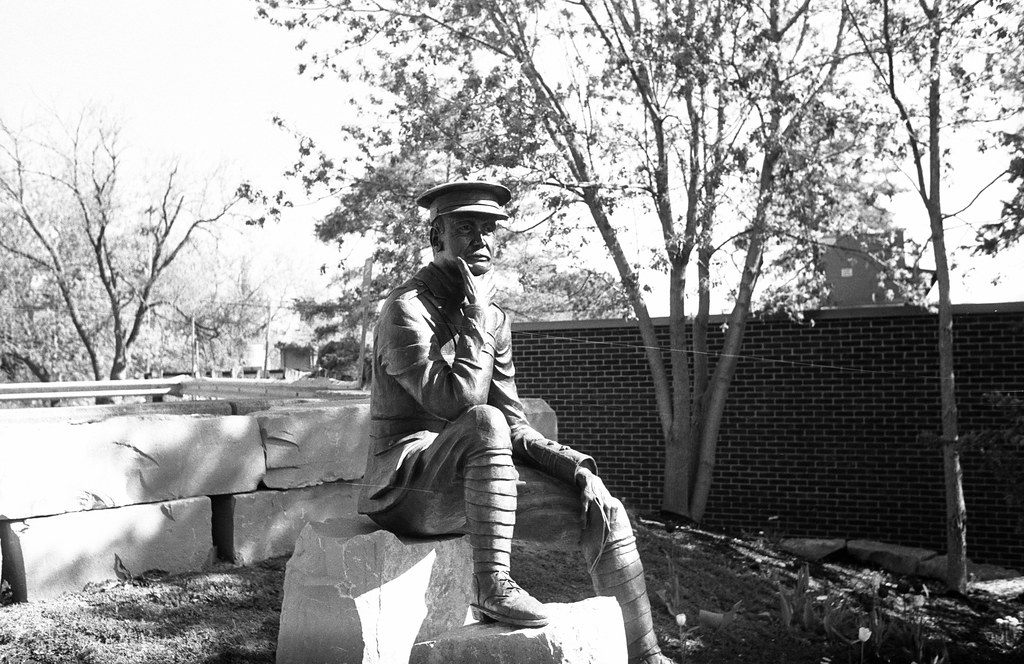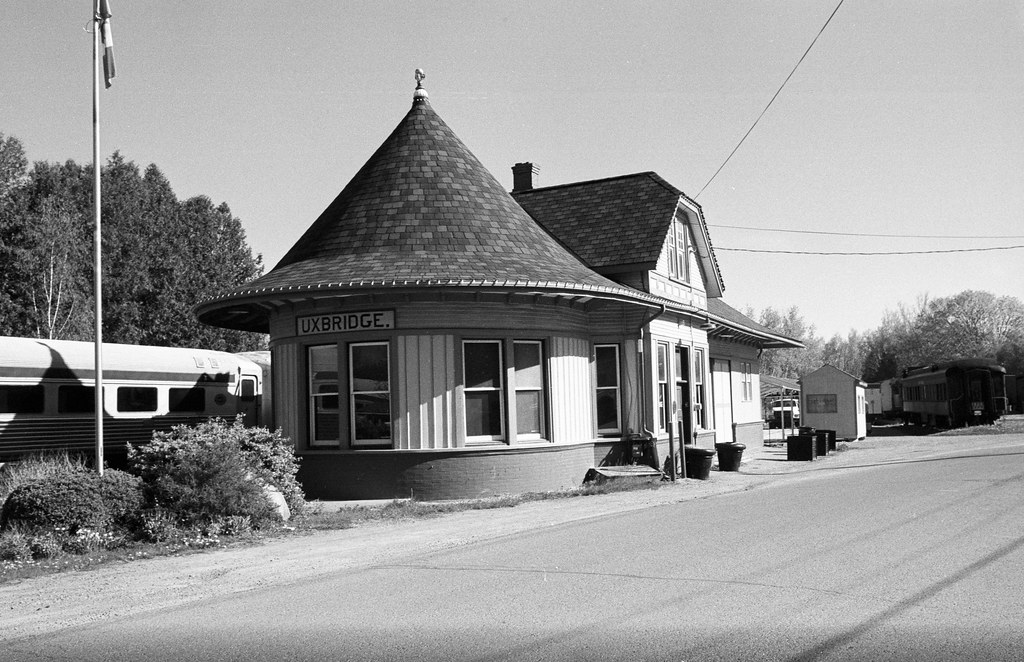When I originally planned out this week of the project, I had a completely different name for the entry, “The Second Wedge”, after Uxbridge’s position in the Second Wedge of the Oak Ridges Moraine and a local craft brewery. But after spotting an interesting statue downtown, which I initially thought was another war memorial, I decided to change the name. It was not another war memorial, not in the cenotaph sense that many communities across Ontario feature in their downtown; this was a memorial to Samuel Sharpe. A Lieutenant-Colonel in World War One, Distinguished Service Order recipient, Member of Parliament, and dead at 45 by suicide. And yes, the title is a play on the famous series by Bernard Cornwall.

Nikon FM – AI-S Nikkor 35mm 1:2.8 (Yellow-12) – Fomapan 100 @ ASA-100 – Adox FX-39 II (1+9) 7:00 @ 20C
While the exact start of human settlement in the Oak Ridges Moraine is unknown, the first peoples to settle in the region were the Huron-Wendate, Haudenosaunee in the 15th and 16th Centuries, followed by the Mississauga and Chippewa. By the time the first European settlers arrived in the area, the region remained occupied by the Mississauga and Chippewa, but no treaty was given in exchange for European settlement. Dr Christopher Beswick and twelve Quaker families moved into the region, establishing a small settlement in 1806. While farming remained the primary occupation in the small Hamlet, Dr Beswick began constructing a dam to complete a couple of mills to support the community. By 1820 the settlement had grown and several buildings, including a meeting house where the large Quaker population met and worshipped. The building still stands today and was for a generation the only church in the settlement. While Dr Beswick remained a pillar of the community, he was by the 1830s getting on in years. A local boy, Joseph Gould, the second child born in Uxbridge, purchased Beswick’s properties in 1832, compiling both a sawmill and a grist mill which attracted far more settlers to the region. The name Uxbridge was given when the first post office opened in 1836, with Joseph Bascom as postmaster. Gould would become a major influence on the growth of the community and one of the voices who supported William Lyon MacKenzie during the turbulent uprisings in 1837 and 1836. Under Gould, through the 1850s, a Mechanic’s Institute, Library, and Schools were opened. And the community grew rapidly through the 1850s. In the form of the Toronto & Nipissing, the railroad arrived in 1871 and allowed incorporation as a village to take place in 1872. Uxbridge served as the headquarters for the Toronto & Nipissing Railroad until 1882, when it was absorbed into Midland, and eventually, Grand Trunk took over. In 1885 Uxbridge was incorporated as a town and separated from the township of the same name. A year later, Joseph Gould passed away. His granddaughter, Mabel Crosby, would marry a young lawyer, Samuel S. Sharpe, in 1903. Sharpe would in 1908 be elected to the House of Commons 1908, representing the riding of Ontario North. Sharpe had made a name for himself in Uxbridge both as a lawyer and an officer in the 34th Ontario Regiment, attaining the rank of Major. Prime Minister Robert Bordon even tapped Sharpe as Minister of Militia and Defence but would go with Sam Hughes instead. Sharpe and Hughes often fought, and it is for that reason Sharpe felt that he was passed over for command of a battalion in the Canadian Expeditionary Force in 1914. A year later, Sharpe commissioned a Lieutenant-Colonel and authorised to raise the 116th (Ontario) Battalion CEF, which would go into action in 1917. Sharpe would lead his men, many of whom he knew well from Uxbridge and the 34th, through Vimy Ridge, Avion, and Passchendaele. Sharpe would run again for a seat in the 1917 election and be elected, the only MP to be elected from the battlefield. Although the increased and steady loss of life would have massive effects on his mental health and he would be sent to England at the end of the year. While he was awarded the Distinguished Service Order in 1918, his mental health continued to suffer. Today we know this as Post-Traumatic Stress Disorder. He was ordered back to Canada to rest at home but would be hospitalised at the Royal Victoria Hospital in Montreal upon arrival in May 1918 and jump to his death on 25 May 1918. The Federal government would quietly sweep the issue under the rug; these things were not talked about a century ago and remain stigmatised even today, although not to the same extent. As for Uxbridge, despite the rapid settlement, the Federal government would sign the last land treaty with the Mississaugas and Chippewas in 1923. The Williams Treaty would provide some land-use rights and financial compensation for the area that were unseeded. The Williams Treaty was hasty and poorly worded, and open for different interpretations. The railroad would cut services in the mid-20th Century by Canadian National, and the town incorporated back into a much larger Township of Uxbridge in 1974. Today the community continues to thrive, with the York-Durham Heritage Railroad operating out of the 1904 Grand Trunk Station and operating a tourist train between Uxbridge and Stouffville. In 2017 a memorial to Sam Sharpe DSO was moved from Ottawa to downtown Uxbridge.

Nikon FM – AI-S Nikkor 35mm 1:2.8 (Yellow-12) – Fomapan 100 @ ASA-100 – Adox FX-39 II (1+9) 7:00 @ 20C
Nikon FM – AI-S Nikkor 35mm 1:2.8 (Yellow-12) – Fomapan 100 @ ASA-100 – Adox FX-39 II (1+9) 7:00 @ 20C
As soon as I saw and read the story of Samuel Sharpe, I knew what the featured image for the week would be. The rest of the town presented plenty of wonderful opportunities. While I could not make it out to where the large collection of historical buildings stand at the local history museum, I did include the 1886 Public Library named Joseph Gould and juxtaposed art deco Roxy Theater. I also included the 1900 Music Hall and a surviving historic hotel. Although there are plenty of other awesome buildings downtown that I wanted to include having only seven slots and plenty of other options, I needed to cut a bunch out so that I could include a couple of images from the York-Durham Heritage railroad, including the 1904 “Witch’s Hat” station (one of five left in Ontario) and a pair of RS3 locomotives that help run the York-Durham Heritage Railroad. Although I’m sure, I was trespassing when I nabbed that photo!

Nikon FM – AI-S Nikkor 35mm 1:2.8 (Yellow-12) – Fomapan 100 @ ASA-100 – Adox FX-39 II (1+9) 7:00 @ 20C
Nikon FM – AI-S Nikkor 35mm 1:2.8 (Yellow-12) – Fomapan 100 @ ASA-100 – Adox FX-39 II (1+9) 7:00 @ 20C
Given that the day I was in Uxbridge, I was also shooting several other cameras. I wanted to keep things simple, so I stuck with a single lens, my 35mm f/2.8, a happy medium that allowed me to easily shoot all the subjects I was working with that day. I think I only wanted additional lenses a couple of times (and I could have used the 28-70/2.8D if I wanted to), but overall I’m happy with the results I got. Because it was a bright sunny day, I threw a Yellow-12 filter onto the lens to help cut back some of the blue light from the harsh, almost summer sun. I shot the film this week at the box speed of ASA-100 and developed it in Adox FX-39 II, a favourite combination I discovered last year, and FX-39 does an excellent job with Fomapan 100. For the most part, I ended up shooting either at the metered exposure or 1/3 stop under to help get those darker skies. The only time I shot over is for the statue of Colonel Sharpe, as I wanted to ensure I got that shadow detail out in the face.

Nikon FM – AI-S Nikkor 35mm 1:2.8 (Yellow-12) – Fomapan 100 @ ASA-100 – Adox FX-39 II (1+9) 7:00 @ 20C
Nikon FM – AI-S Nikkor 35mm 1:2.8 (Yellow-12) – Fomapan 100 @ ASA-100 – Adox FX-39 II (1+9) 7:00 @ 20C
Next week we’re heading to prison, but not really, rather the site of a former historic prison in Guelph, which Public Greenspace now surrounds.